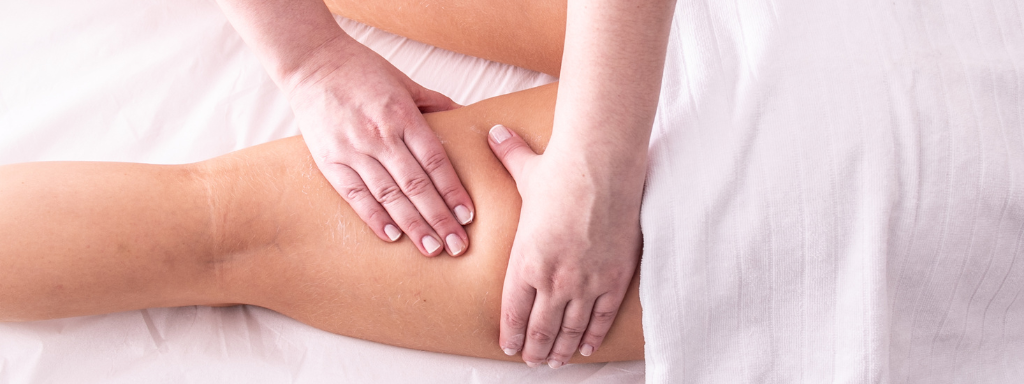
What is lymphatic drainage ?
Lymphatic drainage, or manual lymphatic drainage, is a gentle massage therapy technique that aims to stimulate the circulation of lymph in the body and thus promote the elimination of waste and toxins.
The technique consists of applying superficial circular pressure on the skin with the fingers and the palm of the hands. These pressures follow the path of the lymphatic vessels and the direction of the circulation of the lymph and thus allow the lymph to circulate better in the body.
A few words about the lymphatic system
The lymphatic system acts as a waste disposal system in the body. It comprises a vast network of vessels containing lymph, a clear liquid that circulates through the body thanks to the contraction of muscles and blood vessels. Lymph contains excess fluid from the blood and tissues, but also waste products that are eventually eliminated in the lymph nodes.
When lymphatic circulation is not good in a part of the body, fluid tends to accumulate there. As a result, swelling (oedema) with or without pain may eventually occur. This accumulation of fluid is involved in certain health problems, for example lymphoedema, stretch marks or a feeling of heavy legs. Lymphatic drainage, by imitating the pumping effect caused by the contraction of muscles and blood vessels, can therefore have a beneficial effect in these conditions.
Two techniques of lymphatic drainage
There are two main manual lymphatic drainage techniques:
- The Vodder technique was developed by Emil Vodder in the 1930s. It is based on the principle that the variations of pressures brought by the application of circular pressures along the lymphatic vessels allow the evacuation of the lymph.
- The Leduc technique is derived from the Vodder technique. Developed by the Belgian Albert Leduc, the technique adds drainage manoeuvres performed at a distance from the oedema, as well as resorption manoeuvres performed on the oedema, in addition to the use of pressotherapy devices.
Video demonstrating the Vodder lymphatic drainage technique
What are the benefits of lymphatic drainage?
Lymphatic drainage can be used for both therapeutic and aesthetic purposes. It can for example have beneficial effects in the following situations:
- Presence of lymphoedema resulting from cancer treatment
- Presence of oedema in the limbs
- Recent surgery (e.g. knee, hip, breast, abdomen)
- Recent injury (e.g., bruise, sprain, fracture)
- Presence of scars
- Venous insufficiency
- Heavy legs
- Cellulite (orange peel skin)
In concrete terms, lymphatic drainage brings several benefits to the person who receives it. Here are some of them:
- Reduction of oedema (swelling)
- Reduction of pain
- Acceleration of the body’s natural healing process
- Relaxation and relief
Contraindications
As with other massage therapy techniques, lymphatic drainage is contraindicated in the following situations:
- Malignant tumour
- Fever
- Acute infection
- Heart failure
- Phlebitis
- Thrombophlebitis
- Tuberculosis
It should be noted that the massage therapist always collects information from the client before beginning the treatment. This information will be used, among other things, to identify any contraindications to the massage. In the case of a lymphatic drainage treatment, it is however recommended to obtain prior authorization from the attending physician.
Course of the session
A manual lymphatic drainage treatment usually takes place in the massage therapist’s office, but can also be offered in a hospital, spa or beauty centre.
The massage therapist will begin the session by gathering information. To do this, they will have the client fill out a health questionnaire to identify any contraindications to manual lymphatic drainage.
Since the treatment is applied directly to the skin, the person will be invited to sit on a massage table under a sheet. The therapist will start the lymphatic drainage in the neck area, before moving on to the abdomen. Depending on the client’s needs and health condition, the treatment will end with the upper and lower limbs.
A manual lymphatic drainage session usually lasts between 45 and 75 minutes depending on the reason for the consultation and the client’s needs
Notes :
- Although a session may be devoted exclusively to manual lymphatic drainage, it is also possible to integrate the technique with other approaches as part of a massage therapy treatment (e.g. oncology massage).
- Manual lymphatic drainage can be performed by a massage therapist or by other health professionals such as nurses, physiotherapists and kinesiologists who have completed specialist training.

